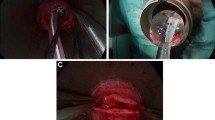Abstract
Introduction
Bacterial contamination from viscerotomy is a barrier to natural orifice translumenal endoscopic surgery (NOTES). The aim of this survival study is to evaluate pure (totally) transvaginal NOTES bacterial contamination compared with laparoscopy in pigs.
Methods
Twelve adult female pigs underwent peritoneoscopy with liver and peritoneal biopsies, using either laparoscopy (Glap, six animals) or pure transvaginal (GNOTES) access, and were maintained alive for 7 days. In all animals, blood cultures were taken at baseline, and after 24 h and 7 days postoperatively. Swab cultures from vagina (GNOTES) and skin (Glap) were obtained pre- and post-antisepsis. Peritoneal fluid culture was obtained at necropsy. For statistical analysis, Glap and GNOTES were compared for presence of positive bacterial cultures (qualitative bacterial analysis) using Fisher’s test, with level of significance set at p < 0.05.
Results
All animals had good postoperative outcome. One animal had transient perioperative bleeding from a transvaginal access. Two animals in Glap and one in GNOTES had positive blood cultures after the procedure. All animals from GNOTES and Glap presented with mixed flora pre-antisepsis. After antisepsis, one animal (GNOTES) presented with a positive vaginal swab culture (a single bacterial strain was identified). There was no positive skin swab culture in Glap. There were no signs of intra-abdominal infection at necropsy. In two animals, one from Glap and another from GNOTES, intra-abdominal culture was positive for Corynebacterium spp. and Escherichia coli, respectively. There was no correlation between the bacterial flora found at the access site and in the peritoneal cultures.
Conclusions
Pure transvaginal peritoneoscopy with liver and peritoneal biopsy in swine is feasible and associated with bacterial contamination comparable to laparoscopy. Peritoneal bacterial contamination was clinically insignificant after 1 week postoperatively. Preoperative antisepsis provided significant reduction of bacterial load prior to transvaginal and laparoscopic procedures.



Similar content being viewed by others
References
Rattner DW, Hawes R, Schwaitzberg S et al (2011) The Second SAGES/ASGE White Paper on natural orifice transluminal endoscopic surgery: 5 years of progress. Surg Endosc 25(8):2441–2448
Mäkinen J, Johansson J, Tomás C et al (2001) Morbidity of 10110 hysterectomies by type of approach. Hum Reprod 16(7):1473–1478
Meltomaa SS, Mäkinen JI, Taalikka MO et al (1999) One-year cohort of abdominal, vaginal, and laparoscopic hysterectomies: complications and subjective outcomes. J Am Coll Surg 189(4):389–396
Lehmann KS, Ritz JP, Wibmer A et al (2010) The German registry for natural orifice translumenal endoscopic surgery: report of the first 551 patients. Ann Surg 252(2):263–270
Zorron R, Palanivelu C, Galvão Neto MP et al (2010) International multicenter trial on clinical natural orifice surgery—NOTES IMTN study: preliminary results of 362 patients. Surg Innov 17(2):142–158
Yang QY, Zhang GY, Wang L et al (2011) Infection during transgastric and transvaginal natural orifice transluminal endoscopic surgery in a live porcine model. Chin Med J (Engl) 124(4):556–561
Lomanto D, Chua HC, Myat MM et al (2009) Microbiological contamination during transgastric and transvaginal endoscopic techniques. J Laparoendosc Adv Surg Technol A 19(4):465–469
Claus CM, Bonin EA, Torres MF, Campos AC, Cury AM, Coelho JC (2011) Liver and peritoneal biopsy by laparoscopy or notes in pigs: comparison of operative parameters and postoperative evolution. Rev Col Bras Cir 38(4):253–259
Spaun GO, Goers TA, Pierce RA et al (2010) Use of flexible endoscopes for NOTES: sterilization or high-level disinfection? Surg Endosc 24(7):1581–1588
Sodergren MH, Pucher P, Clark J et al (2011) Disinfection of the access orifice in NOTES: evaluation of the evidence base. Diagn Ther Endosc 2011:245175. doi:10.1155/2011/245175
Eickhoff A, Vetter S, von Renteln D et al (2010) Effectivity of current sterility methods for transgastric NOTES procedures: results of a randomized porcine study. Endoscopy 42(9):748–752
Ellenhorn JD, Smith DD, Schwarz RE et al (2005) Paint-only is equivalent to scrub-and-paint in preoperative preparation of abdominal surgery sites. J Am Coll Surg 201(5):737–741
Narula VK, Hazey JW, Renton DB et al (2008) Transgastric instrumentation and bacterial contamination of the peritoneal cavity. Surg Endosc 22(3):605–611
Culligan PJ, Kubik K, Murphy M, Blackwell L, Snyder J (2005) A randomized trial that compared povidone iodine and chlorhexidine as antiseptics for vaginal hysterectomy. Am J Obstet Gynecol 192(2):422–425
Ramamoorthy SL, Lee JK, Mintz Y et al (2010) The impact of proton-pump inhibitors on intraperitoneal sepsis: a word of caution for transgastric NOTES procedures. Surg Endosc 24(1):16–20
Löfgren M, Poromaa IS, Stjerndahl JH, Renström B (2004) Postoperative infections and antibiotic prophylaxis for hysterectomy in Sweden: a study by the Swedish National Register for Gynecologic Surgery. Acta Obstet Gynecol Scand 83(12):1202–1207
Van Eyk N, van Schalkwyk J, Infectious Diseases Committee (2012) Antibiotic prophylaxis in gynaecologic procedures. J Obstet Gynaecol Can 34(4):382–391
Hashiba K, Siqueira PR, Brasil HA et al (2010) Expandable gastric port for natural orifice translumenal endoscopic surgery. J Laparoendosc Adv Surg Technol A 20(7):623–625
Wilhelm D, Meining A, von Delius S et al (2007) An innovative, safe and sterile sigmoid access (ISSA) for NOTES. Endoscopy 39(5):401–406
Brandt CM, Spellerberg B (2009) Human infections due to Streptococcus dysgalactiae subspecies equisimilis. Clin Infect Dis 49(5):766–772
Acknowledgments
The authors would like to acknowledge Lyssandra Cravucov and Jordani Rodrigues for helping with collection of all samples used in the study. We would also like to acknowledge Sirlei Pereira and Vanderlei Muller for preparing and caring for the animals used in the study.
Disclosures
Drs. Eduardo Aimore Bonin, Christiano Marlo Paggi Claus, Antonio Carlos Ligocki Campos, and Marcelo de Paula Loureiro and Veterinarian Maria Fernanda Torres have no conflicts of interest or financial ties to disclose. Dr. Leandro Totti Cavazzola is an Advisory Board Member for Hernia for Bard and a Consultant for Hernia for Covidien; none of these relations has relevance for the present study.
Author information
Authors and Affiliations
Corresponding author
Rights and permissions
About this article
Cite this article
Aimore Bonin, E., Claus, C.M.P., Torres, M.F. et al. Evaluation of bacterial contamination after “pure” (totally) transvaginal NOTES® diagnostic peritoneoscopy with biopsies in swine: a comparative study with laparoscopy. Surg Endosc 27, 421–427 (2013). https://doi.org/10.1007/s00464-012-2448-4
Received:
Accepted:
Published:
Issue Date:
DOI: https://doi.org/10.1007/s00464-012-2448-4




